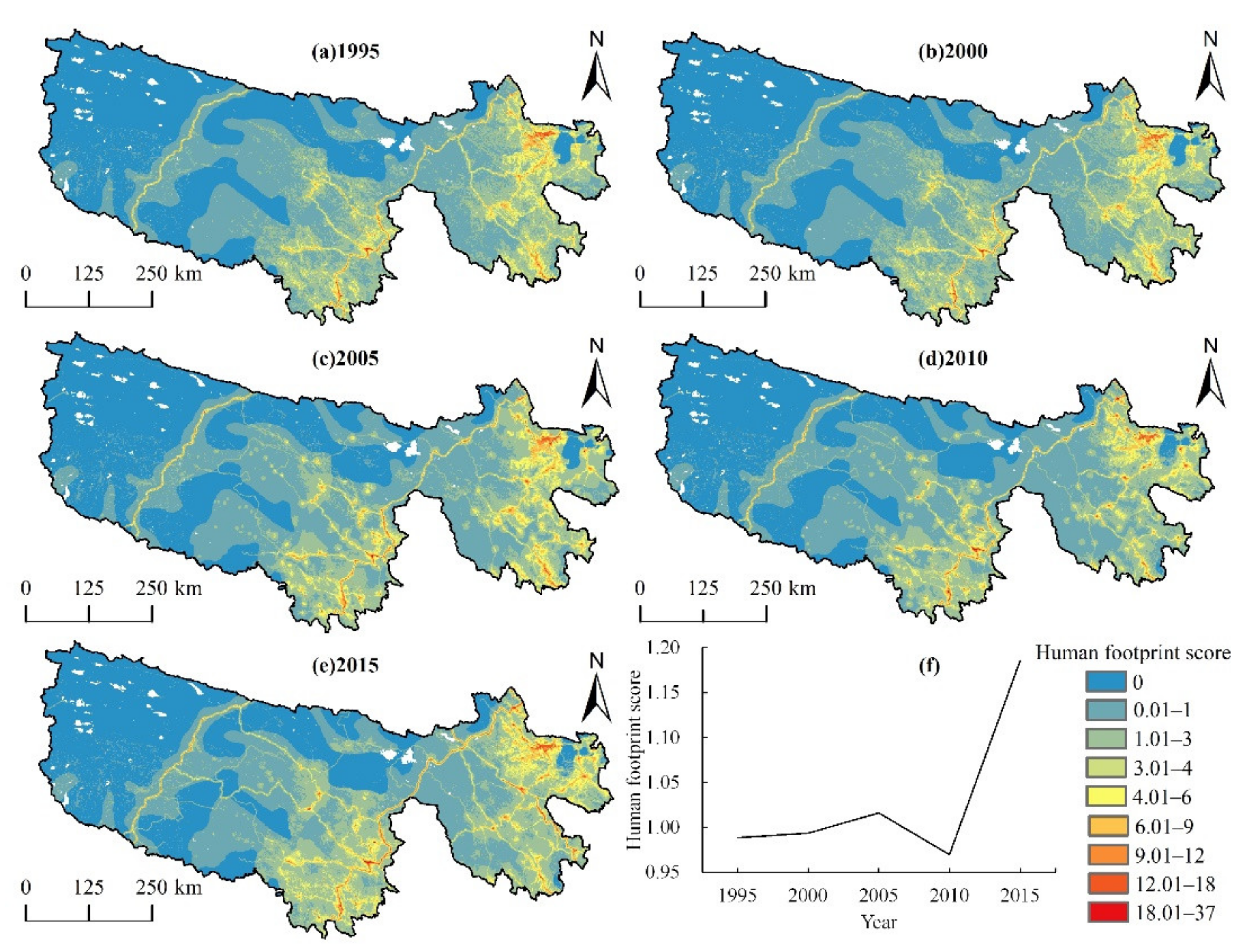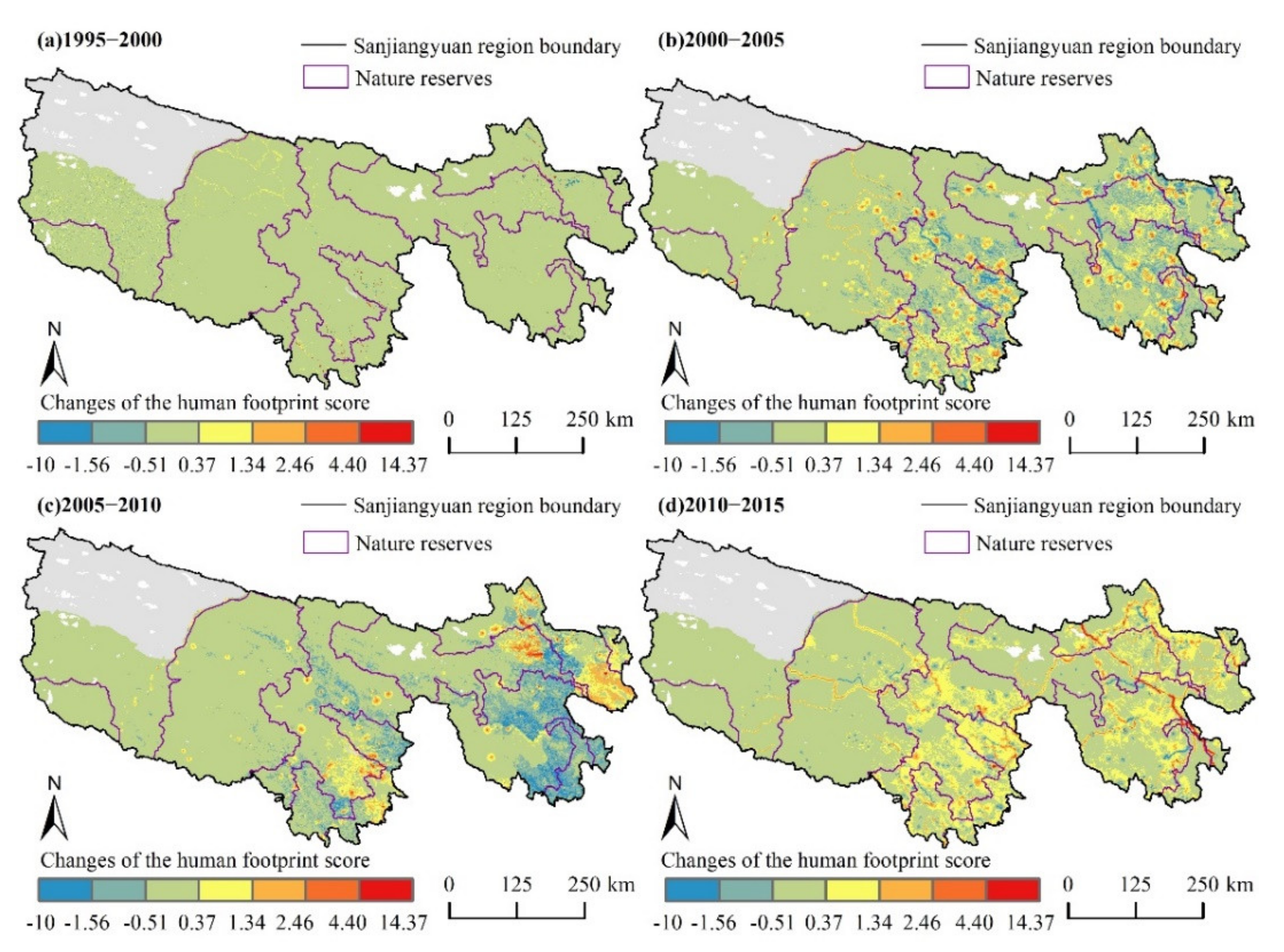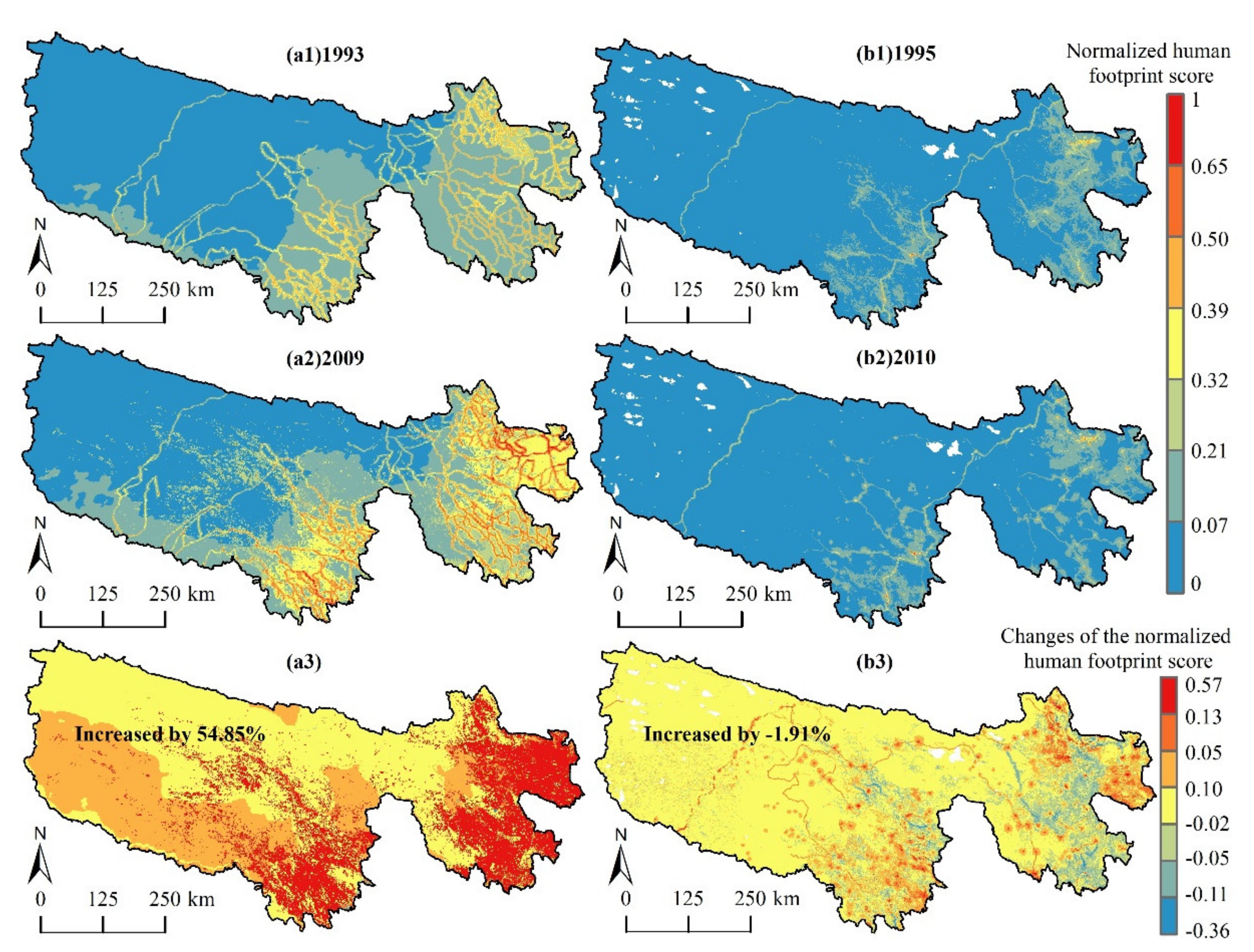The Sanjiangyuan Nature Reserve Is Partially Effective in Mitigating Human Pressures
Abstract
:1. Introduction
2. Materials and Methods
2.1. Study Area
2.2. HF Mapping
2.2.1. Population Density
2.2.2. Land Use Activity
2.2.3. Grazing Intensity
2.2.4. Nighttime Lights
2.2.5. Roads
2.2.6. Summation of Influence Scores
2.3. Assessment of the Effectiveness in Reducing Human Pressures
2.4. Validation Methods
3. Results
3.1. Spatio-Temporal Changes of the HF for 1995–2015 in the Sanjiangyuan Region
3.2. Effectiveness of the SNR in Mitigating Human Activities
3.2.1. Changes of the HF within and outside the SNR
3.2.2. Changes of the HF in Each Functional Zone of the SNR
4. Discussion
4.1. Validation for the HF Model
4.2. Comparisons with Global Datasets and Other Assessments
4.3. Analyses of Differences in Conservation Effectiveness
4.4. Limitations and Future Works
5. Conclusions
Author Contributions
Funding
Institutional Review Board Statement
Informed Consent Statement
Data Availability Statement
Acknowledgments
Conflicts of Interest
References
- Dirzo, R.; Raven, P.H. Global state of biodiversity and loss. Annu. Rev. Env. Resour. 2003, 28, 137–167. [Google Scholar] [CrossRef] [Green Version]
- Motesharrei, S.; Rivas, J.; Kalnay, E.; Asrar, G.R.; Busalacchi, A.J.; Cahalan, R.F.; Cane, M.A.; Colwell, R.R.; Feng, K.S.; Franklin, R.S.; et al. Modeling sustainability: Population, inequality, consumption, and bidirectional coupling of the Earth and Human Systems. Natl. Sci. Rev. 2016, 3, 470–494. [Google Scholar] [CrossRef] [Green Version]
- Xu, W.; Xiao, Y.; Zhang, J.; Yang, W.; Zhang, L.; Hull, V.; Wang, Z.; Zheng, H.; Liu, J.; Polasky, S.; et al. Strengthening protected areas for biodiversity and ecosystem services in China. Proc. Natl. Acad. Sci. USA 2017, 114, 1601–1606. [Google Scholar] [CrossRef] [Green Version]
- Watson, J.E.M.; Dudley, N.; Segan, D.B.; Hockings, M. The performance and potential of protected areas. Nature 2014, 515, 67–73. [Google Scholar] [CrossRef]
- Secretariat of the Convention on Biological Diversity. Global Biodiversity Outlook 5; World Trade Centre: Montreal, QC, Canada, 2020; pp. 5–19. [Google Scholar]
- Gray, C.L.; Hill, S.; Newbold, T.; Hudson, L.N.; Börger, L.; Contu, S.; Hoskins, A.J.; Ferrier, S.; Purvis, A.; Scharlemann, J. Local biodiversity is higher inside than outside terrestrial protected areas worldwide. Nat. Commun. 2016, 7, 12306. [Google Scholar] [CrossRef] [PubMed] [Green Version]
- Leberger, R.; Rosa, I.M.D.; Guerra, C.A.; Wolf, F.; Pereira, H.M. Global patterns of forest loss across IUCN categories of protected areas. Biol. Conserv. 2020, 241, 108299. [Google Scholar] [CrossRef]
- Joppa, L.N.; Pfaff, A. Global protected area impacts. Proc. R. Soc. 2011, 278, 1633–1638. [Google Scholar] [CrossRef] [Green Version]
- Chen, Y.; Zhang, J.; Jiang, J.; Nielsen, S.E.; He, F. Assessing the effectiveness of China’s protected areas to conserve current and future amphibian diversity. Divers. Distrib. 2017, 23, 146–157. [Google Scholar] [CrossRef]
- Terraube, J.; Van Doninck, J.; Helle, P.; Cabeza, M. Assessing the effectiveness of a national protected area network for carnivore conservation. Nat. Commun. 2020, 11, 2957. [Google Scholar] [CrossRef] [PubMed]
- Tammeleht, E.; Kull, A.; Parna, K. Assessing the importance of protected areas in human-dominated lowland for brown bear (Ursus arctos) winter denning. Mammal Res. 2020, 65, 105–115. [Google Scholar] [CrossRef]
- Jordaan, M.S.; Chakona, A.; van der Colff, D. Protected Areas and Endemic Freshwater Fishes of the Cape Fold Ecoregion: Missing the Boat for Fish Conservation? Front. Environ. Sci. 2020, 8, 502042. [Google Scholar] [CrossRef]
- Zeng, J.; Chen, T.; Yao, X.; Chen, W. Do Protected Areas Improve Ecosystem Services? A Case Study of Hoh Xil Nature Reserve in Qinghai-Tibetan Plateau. Remote Sens. 2020, 12, 471. [Google Scholar] [CrossRef] [Green Version]
- Benavidez-Silva, C.; Jensen, M.; Pliscoff, P. Future Scenarios for Land Use in Chile: Identifying Drivers of Change and Impacts over Protected Area System. Land 2021, 10, 408. [Google Scholar] [CrossRef]
- Vukomanovic, J.; Singh, K.K.; Vogler, J.B.; Meentemeyer, R.K. Protection status and proximity to public-private boundaries influence land use intensification near US parks and protected areas. Conserv. Sci. Pract. 2020, 2, e190. [Google Scholar]
- Poor, E.E.; Jati, V.I.M.; Imron, M.A.; Kelly, M.J. The road to deforestation: Edge effects in an endemic ecosystem in Sumatra, Indonesia. PLoS ONE 2019, 14, e0217540. [Google Scholar]
- Broder, L.; Tatin, L.; Danielczak, A.; Seibel, T.; Hochkirch, A. Intensive grazing as a threat in protected areas: The need for adaptive management to protect the Critically Endangered Crau plain grasshopper Prionotropis rhodanica. Oryx 2019, 53, 239–246. [Google Scholar] [CrossRef] [Green Version]
- Prowse, T.A.A.; O’Connor, P.J.; Collard, S.J.; Rogers, D.J. Eating away at protected areas: Total grazing pressure is undermining public land conservation. Glob. Ecol. Conserv. 2019, 20, e00754. [Google Scholar] [CrossRef]
- Andrade-Nunez, M.J.; Aide, T.M. Using nighttime lights to assess infrastructure expansion within and around protected areas in South America. Environ. Res. Commun. 2020, 2, 021002. [Google Scholar] [CrossRef]
- Li, G.Y.; Gao, J.X.; Li, L.Z.; Hou, P. Human pressure dynamics in protected areas of China based on nighttime light. Glob. Ecol. Conser. 2020, 24, e01222. [Google Scholar] [CrossRef]
- Sanderson, E.W.; Jaiteh, M.; Levy, M.A.; Redford, K.H.; Wannebo, A.V.; Woolmer, G. The Human Footprint and the Last of the Wild. BioScience 2002, 52, 891–904. [Google Scholar] [CrossRef]
- Venter, O.; Sanderson, E.W.; Magrach, A.; Allan, J.R.; Beher, J.; Jones, K.R.; Possingham, H.P.; Laurance, W.F.; Wood, P.; Fekete, B.M.; et al. Global terrestrial Human Footprint maps for 1993 and 2009. Sci. Data 2016, 3, 160067. [Google Scholar] [CrossRef] [Green Version]
- Venter, O.; Sanderson, E.W.; Magrach, A.; Allan, J.R.; Beher, J.; Jones, K.R.; Possingham, H.P.; Laurance, W.F.; Wood, P.; Fekete, B.M.; et al. Sixteen years of change in the global terrestrial human footprint and implications for biodiversity conservation. Nat. Commun 2016, 7, 12558. [Google Scholar] [CrossRef] [PubMed] [Green Version]
- Li, S.; Wu, J.; Gong, J.; Li, S. Human footprint in Tibet: Assessing the spatial layout and effectiveness of nature reserves. Sci. Total Environ. 2018, 621, 18–29. [Google Scholar] [CrossRef] [PubMed]
- Yin, L.; Dai, E.F.; Zheng, D.; Wang, Y.H.; Ma, L.; Tong, M. Spatio-temporal analysis of the human footprint in the Hengduan Mountain region: Assessing the effectiveness of nature reserves in reducing human impacts. J. Geogr. Sci. 2020, 30, 1140–1154. [Google Scholar] [CrossRef]
- Tapia-Armijos, M.F.; Homeier, J.; Draper Munt, D. Spatio-temporal analysis of the human footprint in South Ecuador: Influence of human pressure on ecosystems and effectiveness of protected areas. Appl. Geogr. 2017, 78, 22–32. [Google Scholar] [CrossRef]
- Karimi, A.; Jones, K. Assessing national human footprint and implications for biodiversity conservation in Iran. Ambio 2020, 49, 1506–1518. [Google Scholar] [CrossRef]
- Martinuzzi, S.; Radeloff, V.C.; Pastur, G.M.; Rosas, Y.M.; Lizarraga, L.; Politi, N.; Rivera, L.; Herrera, A.H.; Silveira, E.M.O.; Olah, A.; et al. Informing forest conservation planning with detailed human footprint data for Argentina. Glob. Ecol. Conserv. 2021, 31, e01787. [Google Scholar] [CrossRef]
- Geldmann, J.; Joppa, L.N.; Burgess, N.D. Mapping change in human pressure globally on land and within protected areas. Conserv. Biol. 2014, 28, 1604–1616. [Google Scholar] [CrossRef]
- Jones, K.R.; Venter, O.; Fuller, R.A.; Allan, J.R.; Maxwell, S.L.; Negret, P.J.; Watson, J.E.M. One-third of global protected land is under intense human pressure. Science 2018, 360, 788–791. [Google Scholar] [CrossRef] [Green Version]
- Zhang, H. Research on Ecological Conservation and Construction Project Planning of Sanjiangyuan in Qinghai Province; Qinghai People’s Press: Xining, China, 2012; p. 1. [Google Scholar]
- Dwiyahreni, A.A.; Fuad, H.A.H.; Muhtar, S.; Soesilo, T.E.B.; Margules, C.; Supriatna, J. Changes in the human footprint in and around Indonesia’s terrestrial national parks between 2012 and 2017. Sci. Rep. UK 2021, 11, 4510. [Google Scholar] [CrossRef]
- Stevens, F.R.; Gaughan, A.E.; Linard, C.; Tatem, A.J. Disaggregating census data for population mapping using random forests with remotely-sensed and ancillary data. PLoS ONE 2015, 10, e0107042. [Google Scholar]
- Lu, X.; Chen, C.; Fu, J.Q. IEEE Spatial-temporal Variation of LUCC in Zhoushan from 1985 to 2015 Using Remote Sensing Images. In Proceedings of the IGARSS 2018—2018 IEEE International Geoscience and Remote Sensing Symposium, Valencia, Spain, 22–27 July 2018; pp. 834–837. [Google Scholar]
- Li, S.; Bing, Z.; Jin, G. Spatially Explicit Mapping of Soil Conservation Service in Monetary Units Due to Land Use/Cover Change for the Three Gorges Reservoir Area, China. Remote Sens. 2019, 11, 468. [Google Scholar] [CrossRef] [Green Version]
- Li, S.C.; Zhang, Y.L.; Wang, Z.F.; Li, L.H. Mapping human influence intensity in the Tibetan Plateau for conservation of ecological service functions. Ecosyst. Serv. 2018, 30, 276–286. [Google Scholar] [CrossRef]
- Hu, J.; Wu, J.; Ma, M.; Nielsen, U.N.; Wang, J.; Du, G. Nematode communities response to long-term grazing disturbance on Tibetan plateau. Eur. J. Soil Biol. 2015, 69, 24–32. [Google Scholar] [CrossRef]
- Yin, X.; Wang, X.; Huang, R.; Gao, M. Response of Landscape Pattern Gradient to Human Activity Intensity in the Three Gorges Reservoir Area of Chongqing. Resour. Environ. Yangtze Basin 2018, 27, 2718–2732. [Google Scholar]
- Gao, X.; Cao, X.; Li, T.; Lv, M. Evolution of accessibility spatial pattern of the Qinghai-Tibet Plateau in 1976–2016. Acta Geogr. Sin. 2019, 74, 1190–1204. [Google Scholar]
- Raiter, K.G.; Possingham, H.P.; Prober, S.M.; Hobbs, R.J. Under the radar: Mitigating enigmatic ecological impacts. Trends Ecol. Evol. 2014, 29, 635–644. [Google Scholar] [CrossRef] [Green Version]
- Williams, B.A.; Venter, O.; Allan, J.R.; Atkinson, S.C.; Rehbein, J.A.; Ward, M.; Di Marco, M.; Grantham, H.S.; Ervin, J.; Goetz, S.J.; et al. Change in Terrestrial Human Footprint Drives Continued Loss of Intact Ecosystems. One Earth 2020, 3, 371–382. [Google Scholar] [CrossRef]
- Kennedy, C.M.; Oakleaf, J.R.; Theobald, D.M.; Baruch-Mordo, S.; Kiesecker, J. Managing the middle: A shift in conservation priorities based on the global human modification gradient. Glob. Chang. Biol. 2019, 25, 811–826. [Google Scholar] [CrossRef]
- Willmott, C.J.; Matsuura, K. Advantages of the mean absolute error (MAE) over the root mean square error (RMSE) in assessing average model performance. Clim. Res. 2005, 30, 79–82. [Google Scholar] [CrossRef]
- Viera, A.J.; Garrett, J.M. Understanding interobserver agreement: The kappa statistic. Fam. Med. 2005, 37, 360–363. [Google Scholar]
- Woolmer, G.; Trombulak, S.C.; Ray, J.C.; Doran, P.J.; Anderson, M.G.; Baldwin, R.F.; Morgan, A.; Sanderson, E.W. Rescaling the Human Footprint: A tool for conservation planning at an ecoregional scale. Landsc. Urban. Plan. 2008, 87, 42–53. [Google Scholar] [CrossRef]
- Shao, Q.; Zhao, Z.; Liu, J.; Fan, J. The characteristics of land cover and macroscopical ecology changes in the source region of three rivers on Qinghai-Tibet Plateau during last 30 years. Geogr. Res. 2010, 29, 1439–1451. [Google Scholar]
- Yi, J.; Du, Y.; Liang, F.; Tu, W.; Qi, W.; Ge, Y. Mapping human’s digital footprints on the Tibetan Plateau from multi-source geospatial big data. Sci. Total Envir. 2020, 711, 134540. [Google Scholar] [CrossRef]
- Liu, H. Research on compensation Mechanism and policy of ecological migration in Sanjiangyuan region. J. S. Cent. Univ. Natl. (Hum. Soc. Sci. Ed.) 2013, 33, 101–105. [Google Scholar]
- Zhu, G.; Zhao, K.; Liu, J.; Yang, F.; Gao, Y.; Lin, J.; Han, D.; Xu, H.; Jiang, J.; Sun, H. Study on Ecological Conflict and Coordination of Highway Network Planning—A Case Study of the Three-River Headwater Region of Qinghai-Tibet Plateau. J. Cap. Norm. Univ. (Nat. Sci. Ed.) 2020, 41, 57–63. [Google Scholar]
- Zhai, X.H.; Liang, X.L.; Yan, C.Z.; Xing, X.G.; Jia, H.W.; Wei, X.X.; Feng, K. Vegetation Dynamic Changes and Their Response to Ecological Engineering in the Sanjiangyuan Region of China. Remote Sens. 2020, 12, 4025. [Google Scholar] [CrossRef]
- Han, S.; Meng, Q.; Liu, H.; Peng, Y.; Han, J.; Jin, S.; Fan, S.; Xin, B.; He, L.; Li, H. Refined land-cover classification mapping using a multi-scale transformation method from remote sensing, unmanned aerial vehicle, and field surveys in Sanjiangyuan National Park, China. J. Appl. Remote Sens. 2021, 15, 014513. [Google Scholar] [CrossRef]
- The State Council. Regulations of the People’s Republic of China on natural reserves. State Counc. Bull. 1994, 12, 991–998. [Google Scholar]
- First National Park Receiving Strong Legal and Financial Support. Available online: http://www.chinadaily.com.cn/china/2017-03/09/content_28485917.htm (accessed on 9 March 2017).
- Chung, M.G.; Pan, T.; Zou, X.T.; Liu, J.G. Complex Interrelationships between Ecosystem Services Supply and Tourism Demand: General Framework and Evidence from the Origin of Three Asian Rivers. Sustainability 2018, 10, 4576. [Google Scholar] [CrossRef] [Green Version]
- Lu, S.J.; Si, J.H.; Hou, C.Y.; Li, Y.S.; Wang, M.M.; Yan, X.X.; Xie, M.; Sun, J.X.; Chen, B.J.; Li, S.S. Spatiotemporal distribution of nitrogen and phosphorus in alpine lakes in the Sanjiangyuan Region of the Tibetan Plateau. Water Sci. Technol. 2017, 76, 396–412. [Google Scholar] [CrossRef] [PubMed]
- Vilar, C.C.; Magris, R.A.; Loyola, R.; Joyeux, J.C. Strengthening the synergies among global biodiversity targets to reconcile conservation and socio-economic demands. Aquat. Conserv. 2020, 30, 497–513. [Google Scholar] [CrossRef]
- Sloan, S.; Sayer, J.A. Forest Resources Assessment of 2015 shows positive global trends but forest loss and degradation persist in poor tropical countries. Forest Ecol. Manag. 2015, 352, 134–145. [Google Scholar] [CrossRef] [Green Version]




| Land Use Type | Urban Built-Up | Other Construction Land | Rural Settlements | Dry Land | Other Woodlands | Forest-Land | Stream, Rivers, Reservoir/Ponds | Tidal Flat, Bottomland | Shrubland, WOODLAND | Lakes, Glaciers, and Permanent Snow | Unused Land |
|---|---|---|---|---|---|---|---|---|---|---|---|
| Score | 10 | 9 | 8 | 7 | 2 | 1 | 1 | 1 | 0 | 0 | 0 |
| Road Type | Buffering Distance | ||
| 0–1 km | 1–2 km | 2–5 km | |
| Expressway | 10 | 6 | 3 |
| Railway | 8 | 4 | 1 |
| National-level highway | 8 | 4 | 2 |
| Provincial-level road | 4 | 2 | 1 |
| County-level road | 2 | 1 | 0 |
| Human Pressures | 1995 | 2000 | 2005 | 2010 | 2015 |
|---|---|---|---|---|---|
| Population density | 0.6150 | 0.6150 | 0.6205 | 0.6406 | 0.7763 |
| Land use intensity | 0.0385 | 0.0436 | 0.0444 | 0.0445 | 0.0456 |
| Grazing intensity | 0.2111 | 0.2111 | 0.2111 | 0.1422 | 0.1422 |
| Roads | 0.1180 | 0.1180 | 0.1370 | 0.1370 | 0.2153 |
| Nighttime lights | 0.0004 | 0.0004 | 0.0004 | 0.0032 | 0.0040 |
| Human Pressures | Changes in Human Pressure Values | |||||||||
|---|---|---|---|---|---|---|---|---|---|---|
| 1995–2000 | 2000–2005 | 2005–2010 | 2010–2015 | 1995–2015 | ||||||
| within | outside | within | outside | within | outside | within | outside | within | outside | |
| Population density | 0.0000 | 0.0000 | 0.0020 | 0.0042 | 0.0371 | 0.0095 | 0.1323 | 0.1775 | 0.1714 | 0.1912 |
| Land use intensity | 0.0106 | 0.0008 | 0.0004 | 0.0015 | −0.0002 | 0.0005 | 0.0004 | 0.0015 | 0.0112 | 0.0043 |
| Grazing intensity | 0.0000 | 0.0000 | 0.0000 | 0.0000 | −0.0689 | −0.0900 | 0.0000 | 0.0000 | −0.0689 | −0.0900 |
| Roads | 0.0000 | 0.0000 | 0.0291 | 0.0131 | 0.0000 | 0.0000 | 0.0789 | 0.1008 | 0.1080 | 0.1139 |
| Nighttime lights | 0.0000 | 0.0000 | 0.0000 | −0.0002 | 0.0007 | 0.0057 | 0.0002 | 0.0015 | 0.0009 | 0.0070 |
| HF value | 0.0108 | 0.0008 | 0.0313 | 0.0176 | −0.0317 | −0.0746 | 0.2123 | 0.2815 | 0.2227 | 0.2253 |
| Functional Zones | Human Pressures | Changes in Human Pressure Values | ||||
|---|---|---|---|---|---|---|
| 1995–2000 | 2000–2005 | 2005–2010 | 2010–2015 | 1995–2015 | ||
| Core areas | Population density | 0.0000 | 0.0057 | 0.0219 | 0.0973 | 0.1249 |
| Land use intensity | 0.0089 | 0.0011 | −0.0006 | 0.0001 | 0.0095 | |
| Grazing intensity | 0.0000 | 0.0000 | −0.0225 | 0.0000 | −0.0225 | |
| Roads | 0.0000 | 0.0376 | 0.0000 | 0.0617 | 0.0993 | |
| Nighttime lights | 0.0000 | 0.0000 | 0.0000 | 0.0005 | 0.0005 | |
| HF value | 0.0093 | 0.0449 | −0.0015 | 0.1615 | 0.2142 | |
| Buffer areas | Population density | 0.0000 | −0.0014 | 0.0377 | 0.1147 | 0.1510 |
| Land use intensity | 0.0109 | 0.0001 | 0.0003 | 0.0003 | 0.0116 | |
| Grazing intensity | 0.0000 | 0.0000 | −0.0384 | 0.0000 | −0.0384 | |
| Roads | 0.0000 | 0.0312 | 0.0000 | 0.0544 | 0.0856 | |
| Nighttime lights | 0.0000 | 0.0000 | 0.0002 | 0.0001 | 0.0003 | |
| HF value | 0.0109 | 0.0299 | −0.0003 | 0.1695 | 0.2100 | |
| Experimental areas | Population density | 0.0000 | 0.0024 | 0.0426 | 0.1541 | 0.1991 |
| Land use intensity | 0.0111 | 0.0003 | −0.0002 | 0.0006 | 0.0118 | |
| Grazing intensity | 0.0000 | 0.0000 | −0.1033 | 0.0000 | −0.1033 | |
| Roads | 0.0000 | 0.0248 | 0.0000 | 0.0973 | 0.1221 | |
| Nighttime lights | 0.0000 | 0.0000 | 0.0012 | 0.0002 | 0.0014 | |
| HF value | 0.0112 | 0.0268 | −0.0600 | 0.2525 | 0.2305 | |
Publisher’s Note: MDPI stays neutral with regard to jurisdictional claims in published maps and institutional affiliations. |
© 2021 by the authors. Licensee MDPI, Basel, Switzerland. This article is an open access article distributed under the terms and conditions of the Creative Commons Attribution (CC BY) license (https://creativecommons.org/licenses/by/4.0/).
Share and Cite
Tan, L.; Guo, G.; Li, S. The Sanjiangyuan Nature Reserve Is Partially Effective in Mitigating Human Pressures. Land 2022, 11, 43. https://doi.org/10.3390/land11010043
Tan L, Guo G, Li S. The Sanjiangyuan Nature Reserve Is Partially Effective in Mitigating Human Pressures. Land. 2022; 11(1):43. https://doi.org/10.3390/land11010043
Chicago/Turabian StyleTan, Linyi, Guancheng Guo, and Shicheng Li. 2022. "The Sanjiangyuan Nature Reserve Is Partially Effective in Mitigating Human Pressures" Land 11, no. 1: 43. https://doi.org/10.3390/land11010043
APA StyleTan, L., Guo, G., & Li, S. (2022). The Sanjiangyuan Nature Reserve Is Partially Effective in Mitigating Human Pressures. Land, 11(1), 43. https://doi.org/10.3390/land11010043







